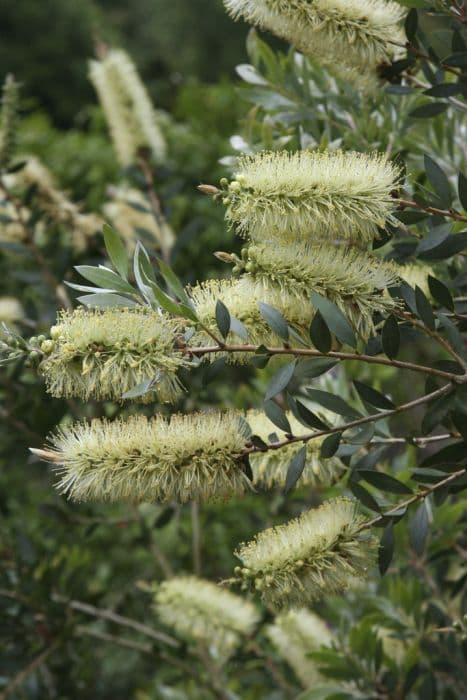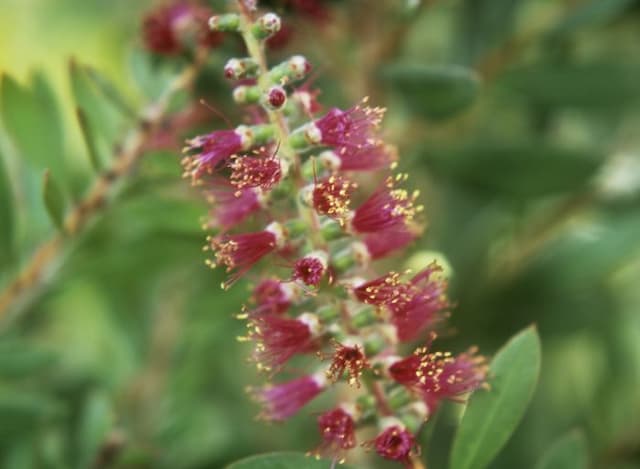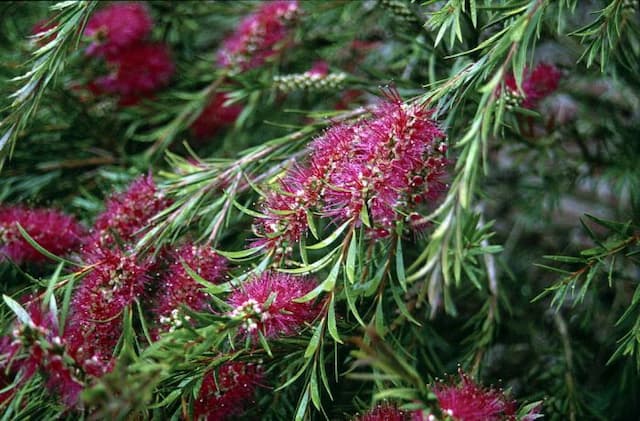Variegated Common Myrtle Myrtus communis 'Variegata' (v)

ABOUT
The Myrtle 'Variegata' is a visually appealing plant characterized mainly by its striking foliage. The leaves are a glossy green with creamy or white irregular edges, creating a variegation that adds depth and contrast to the overall greenery. These leaves are small and oval-shaped, emanating a beautiful aroma when crushed. This plant often blooms in the warmer months, producing delicate white flowers that add a subtle elegance to its appearance. The flowers have a distinctive arrangement, usually with a multitude of petals that give them a fluffy, full look. The Myrtle 'Variegata' is a plant that exudes a classic charm, with its variegated leaves lighting up any garden space. Its scented foliage and beautiful blooms contribute to its popularity as an ornamental plant.
About this plant
 Names
NamesFamily
Myrtaceae
Synonyms
Variegated Myrtle, Variegated True Myrtle, Variegated Common Myrtle
Common names
Myrtus communis 'Variegata'.
 Toxicity
ToxicityTo humans
The common myrtle generally is not known to be toxic to humans. However, consuming large quantities of any plant material may cause digestive discomfort or other non-specific symptoms due to the fibers and compounds not typically part of the human diet.
To pets
The common myrtle is also not recognized as a toxic plant to pets. Similar to humans, ingestion of large amounts could potentially lead to gastrointestinal upset or other non-specific symptoms, but it is not known for containing any substances that are specifically toxic to animals.
 Characteristics
CharacteristicsLife cycle
Perennials
Foliage type
Evergreen
Color of leaves
Variegated
Flower color
White
Height
4-6 feet (1.2-1.8 meters)
Spread
4-6 feet (1.2-1.8 meters)
Plant type
Shrub
Hardiness zones
8
Native area
Mediterranean
Benefits
 General Benefits
General Benefits- Ornamental Appeal: Myrtus communis 'Variegata', commonly known as Variegated Myrtle, boasts attractive foliage with a variegated pattern that adds visual interest to gardens and landscapes.
- Aromatic Foliage: The leaves of the Variegated Myrtle emit a pleasant fragrance when crushed, providing a sensory experience in the garden space.
- Drought Tolerance: Once established, Variegated Myrtle is relatively tolerant of dry conditions, making it suitable for xeriscaping and water-wise gardens.
- Wildlife Attraction: The flowers of the Variegated Myrtle can attract pollinators such as bees and butterflies, enhancing biodiversity.
- In-season Blossoms: Variegated Myrtle produces white flowers in late spring to summer, offering seasonal blossoms that complement garden aesthetics.
- Versatility: This plant can be utilized in various ways, including as a hedge, stand-alone specimen, or container plant, offering flexible landscaping options.
- Ease of Maintenance: With minimal pruning requirements, Variegated Myrtle is user-friendly for gardeners of varying expertise levels.
- Compact Size: It is a relatively small to medium-sized shrub, making it suitable for gardens where space is limited.
- Evergreen Foliage: As an evergreen, Variegated Myrtle provides year-round greenery, keeping the garden vibrant even in colder months.
 Medical Properties
Medical Properties- Antioxidant: Myrtus communis contains compounds that exhibit antioxidant activity, which can help in protecting the body from oxidative stress.
- Antimicrobial: It has been reported to have antimicrobial properties, making it potentially useful against certain bacteria and fungi.
- Astringent: The astringent qualities of Myrtle can be used for tightening the skin and reducing the secretion of fluids, like in cases of diarrhea.
- Expectorant: Myrtle has been used traditionally to help in the relief of respiratory conditions by helping to expel phlegm and mucus from the lungs.
- Anti-inflammatory: Compounds in Myrtle may help in reducing inflammation, beneficial in conditions such as arthritis and other inflammatory diseases.
 Air-purifying Qualities
Air-purifying QualitiesThis plant is not specifically known for air purifying qualities.
 Other Uses
Other Uses- Myrtle 'Variegata' branches can be used in floral arrangements for an added touch of variegation, creating a more visually interesting bouquet.
- Wood from the Myrtle plant can be crafted into small decorative items or used in woodturning due to its fine grain and attractive appearance.
- Dried Myrtle leaves can be incorporated into potpourri mixes for a fragrant addition to your home decor.
- The aromatic leaves of the Myrtle are sometimes used in cooking as a spice, particularly in Mediterranean cuisine, to flavor meats and sauces.
- Apart from its attractiveness, Myrtle 'Variegata' can be used as a natural dye, providing a range of colors from its leaves and berries.
- The dense foliage of Myrtle makes it suitable for creating privacy hedges or topiary in gardens and landscaping projects.
- Myrtle 'Variegata' can be planted in coastal areas, as it is known to tolerate seaside conditions better than many other plants.
- Myrtle essential oil, extracted from the leaves, is used in perfumery and aromatherapy for its uplifting scent.
- The plant can serve as a natural insect repellent when its leaves are crushed and rubbed onto the skin due to its aromatic essential oils.
- Myrtle 'Variegata' can be cultivated as a bonsai tree, making it a popular choice for enthusiasts looking for a variegated variety to add to their collection.
Interesting Facts
 Feng Shui
Feng ShuiThe Variegated Myrtle is not used in Feng Shui practice.
 Zodiac Sign Compitability
Zodiac Sign CompitabilityThe Variegated Myrtle is not used in astrology practice.
 Plant Symbolism
Plant Symbolism- Love: Variegated Myrtle is traditionally associated with love and is often incorporated in wedding bouquets and ceremonies, symbolizing the union and love between two people.
- Peace: The plant has been regarded as a symbol of peace, and ancient rituals used it to signify a peaceful intent, especially in the home.
- Fertility: In some cultures, Myrtle is symbolic of fertility and is thus used to wish for children and a fruitful marriage.
- Chastity: Often associated with chastity, Myrtle's connection to Venus, the goddess of love, ties it to the ideals of purity and virginity.
- Immortality: Myrtle's evergreen nature leads it to be a symbol of eternal life and immortality, representing the undying soul or remembrance.
 Water
WaterVariegated Myrtle should be watered regularly, but it's important to let the soil dry out between waterings to avoid root rot. In general, water the plant thoroughly once every week during the active growing season, using approximately half a gallon for a medium-sized plant. During the dormant winter period, reduce watering to once every two to three weeks, depending on the humidity and temperature of your environment. If the plant is in a particularly hot and dry climate, it may require more frequent watering; always check the top inch of soil for dryness before watering again.
 Light
LightVariegated Myrtle thrives in bright, indirect light but can also tolerate some direct sunlight, particularly in the morning or late afternoon. Too much direct sun can scorch the leaves, so it's best to place the plant in a spot where it will receive a balance of shade and sunlight throughout the day. Avoid placing it in full shade as this can lead to leggy growth and fewer variegations on the leaves.
 Temperature
TemperatureThe Variegated Myrtle prefers a temperate climate with temperatures ranging between 50 and 80 degrees Fahrenheit. It can withstand short periods of cooler weather down to about 20 degrees Fahrenheit, but frost can be damaging, so it's best to protect the plant from extreme cold. The ideal condition is a consistent temperature without sudden drops or spikes, as extreme changes can stress the plant.
 Pruning
PruningPruning Variegated Myrtle is necessary to maintain its shape, encourage bushy growth, and remove any dead or diseased wood. Prune the plant in the late winter or early spring before new growth begins. This is also a good time to trim back any leggy branches to promote a denser foliage canopy. Occasionally, light pruning can be done throughout the year to shape the plant or control its size.
 Cleaning
CleaningAs needed
 Soil
SoilThe best soil mix for Variegated Myrtle (Myrtus communis 'Variegata') is well-draining, enriched with organic matter and a pH ranging from 6.0 to 7.5. A mix of two parts loam, one part peat, and one part perlite or sand can facilitate healthy growth.
 Repotting
RepottingVariegated Myrtle should be repotted every two to three years or when it becomes root-bound. Younger plants may need more frequent repotting, while established plants can be repotted less often.
 Humidity & Misting
Humidity & MistingVariegated Myrtle thrives in moderate to high humidity levels, ideally between 40% and 60%. Consistent humidity is beneficial for the plant's health and vibrant foliage.
 Suitable locations
Suitable locationsIndoor
Keep in bright, indirect light, moderate humidity, and well-draining soil.
Outdoor
Plant in well-drained soil, full sun to partial shade, and shelter from cold winds.
Hardiness zone
8-11 USDA
 Life cycle
Life cycleMyrtus communis 'Variegata', commonly known as Variegated Common Myrtle, begins its life cycle with seed germination, which requires warm temperatures and can be erratic. Upon successful germination, seedlings emerge and grow into young plants, which develop distinctive variegated foliage that is green with creamy-white edges. The juvenile phase progresses as the plant grows and branches, eventually reaching maturity where it can flower and fruit. Mature myrtles typically bloom in the summer, producing fragrant white flowers that are attractive to bees and other pollinators. Following pollination, the plant develops purplish-black berries, which contain seeds that can be dispersed to start new plants, thereby continuing the cycle. Variegated Common Myrtle can also be propagated vegetatively through cuttings, which can shortcut the initial stages and lead to quicker establishment of mature plants.
 Propogation
PropogationPropogation time
Spring-Early Summer
The Variegated Myrtle (Myrtus communis 'Variegata') is commonly propagated by semi-ripe stem cuttings. This method involves selecting a healthy, non-flowering shoot during late summer. The cutting should be about 4 to 6 inches (10 to 15 cm) long and include several leaves. A clean, sharp knife or secateurs should be used to make the cut just below a leaf node, the point on the stem where leaves emerge. The lower leaves are then stripped off, and the base of the cutting is dipped in a rooting hormone to encourage root growth. Afterward, the cutting is inserted into a pot filled with a mix of peat and perlite or a well-draining potting soil. Once potted, the cutting should be placed in a warm spot with indirect light and kept moist. Roots typically develop in a few weeks, after which the new plant can be gradually acclimated to normal growing conditions.









